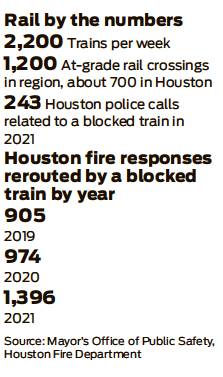Stopped train cars still vex Houston
By Dug Begley STAFF WRITER
Houston and railroads are so interlinked that there is a train on the city’s seal, but those deep ties did not stop city officials and residents this week from unloading a boxcar’s worth of criticism about the ongoing problem of parked trains.
Months of blocked crossings that delay workers, students and deliveries have residents outraged and elected leaders fed up with what they consider insufficient attempts to solve the problem.
“It is more than an inconvenience,” said Judith Cruz, president of the Houston Independent School District board, who represents the eastern and central parts of the district.
Solutions, however, are unlikely to come quickly to a problem that has vexed railroad companies, local elected leaders and community groups. City officials said there is virtually no enforcement authority to penalize the railroads, but they would like to improve communication and documentation of the issues. The city is testing cameras at five locations to detect and then alert officials to stopped trains, as they put more pressure on the companies to act as good neighbors.
“I am feeling desperate about what we can do,” District H Councilwoman Karla Cisneros said, lamenting the lack of immediate options. “Anything that the city can be creative about, I want to support.”
Some major crossings frequently spend hours of the day blocked, posing problems for police and fire response, forcing some pedestrians to make the risky decision to climb across stopped cars and just occupying too much of people’s time as they sit and wait or work their way around blockages. That has a spillover effect, residents said, as commerce on the tracks harms businesses nearby.
“Any barrier, literal, only provides negative images,” said Roy Lira, president of the Second Ward Super-Neighborhood Association, which with other agencies is trying to encourage more local business development on the East Side.
The City Council’s Transportation, Technology and Infrastructure, Quality of Life and Regulatory and Neighborhood Affairs committees met jointly Thursday because council members said the problem of parked trains has worsened in the East End and spread along tracks throughout the city.
“I’ll be honest, I believe that part of the problem has been that railroads have operated under a ‘we were here first’ mentality,” District I Councilman Robert Gallegos said during the three-hour discussion. “While that’s true to a certain extent, we must also recognize that cities have grown from the industrial era — we’ve evolved, diversified and modernized, and with that, the need for the railroads to operate more responsibly has become even more crucial.”
Officials with Union Pacific Railroad, which manages the largest rail system in the region, pleaded for more patience as they work through the challenges and work with the city on some long-term fixes that will take years to develop.
“We don’t ever have a plan to stop a train that blocks a crossing in Houston,” said Clint Schelbitzki, assistant vice president for public affairs for Union Pacific in the company’s Spring office. “Sometimes things don’t work out the way they are intended to.”
Union Pacific was the only railroad to attend the meeting. Burlington Northern Santa Fe was invited, At-Large Councilman David Robinson said, but declined to attend.
Since early 2021, when U.S. Rep. Sylvia Garcia grilled Union Pacific, railroad officials have said increasing freight to and from coastal ports is complicating the synchronized way freight moves along local tracks. Often, because of delays in shuffling cars in the assorted rail yards in the Houston area, trains come into the metro area but are unable to pull into the yards. That, and switching out rail crews, can lead to trains sitting on tracks close to the yards, blocking dozens of street crossings.
The stopped trains are a frequent and frustrating impediment to drivers and businesses.
“If we do not see a train stopped, daily, we feel like something is wrong,” said Manuel Gil, who with his wife, Martha Gil, said trains blocking tracks near Milby upend sales at their Segundo Coffee Lab.
“As soon as a train stops, our numbers go down,” Martha Gil said.
Houston largely is powerless to police the stopped trains. For years, the city and the state had regulations that limited railroads blocking crossings. Those rules, however, were struck down in 2005 by federal courts.
“It made it unenforceable,” said Jack Hanagriff, law enforcement liaison for the Mayor’s Office of Public Safety. The court ruling basically reduced police, when told of blocked crossings, to “only find out what is going on.”
Absent changes in the law, Hanagriff said, officials are focusing on better documenting the delays. New cameras that work with software to spot road-blocking trains — the systems avoid workers having to scan hours of footage — are being installed at five major crossings: 5200 Lawn-dale, 7200 Lawndale and 700 S. Lockwood on the East Side; 1300 N. Durham in the Washington Corridor and 4230 N. Braeswood near Meyerland.
Those cameras, if they prove useful, can better document delays and give police and fire departments better real-time information. Though officials could not point to calamities made worse by their inability to respond, analyses indicate first responders are having to detour more frequently.
“We are not looking to choke off the rail industry, but we have to look at the safety aspect,” Houston Fire Chief Samuel Peña said “It seems like the trains are getting longer, or they are passing more often. … It is having an impact on our ability to respond.”
